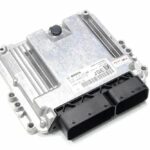The class develops what is the vehicle transmission, its components, the types that exist and recommendations in fleet management.
Slide 2. Car transmission.
The transmission is one of the most important systems of the vehicle, because it transmits the mechanical energy from the combustion engine or electric motor to the wheels. Let's see below, the different types of existing transmissions and the parts that compose them.
- Components of the vehicle transmission system.
These are the different components that make up the transmission system of a car and make it work:
1. Clutch.
The clutch of a car is a fundamental component of the transmission system. Its primary function is to engage and disengage the engine from the drivetrain to allow smooth and efficient gear changes. Basically, the clutch allows the engine to temporarily engage or disengage from the gearbox and transmission, allowing gear changes without bringing the engine to a complete stop.
In a manual car, when you step on the clutch pedal, pressure is released on the clutch disc, which disconnects the engine from the gearbox. This allows you to shift gears without the moving parts of the transmission coming to a screeching halt. Once you shift gears and release the clutch pedal, the engine and transmission are re-engaged, allowing engine power to be transferred continuously to the drive wheels.
2. Gearbox.
It is the component that manages the communication between the wheels and the crankshaft of the engine, it represents a decisive role by taking advantage of the revolutions of the two parts, both the wheels and the crankshaft. Although there are dual models, most gearboxes are usually automatic and manual gearboxes.
Electric vehicles do not have a gearbox, because they have a very high and flat torque from low revolutions.
3. PTO shaft.
The drive shaft is a cylindrical part connected to the gearbox and the differential. It is usually used when the gearbox and differential are on different axles, normally when the gearbox is on the front axle and the differential on the rear axle.
In some vehicles, this component may be omitted from the transmission system when the gearbox and differential are on the same axle as in most passenger cars and SUVs.
4. Differential group.
When the longitudinal movement reaches the driveshaft, it is connected to the cone-differential group. Its purpose is to transform this movement into a transverse direction, which is then directed to the axle shafts. It also ensures that the sum of the speeds at the driving wheels remains constant, which helps prevent skidding when cornering.
5. Bearing shafts.
When the longitudinal movement reaches the drive shaft, it is connected to the differential group, which has the function of converting this movement into a transverse direction, subsequently directed towards the axle shafts.
The axle shafts, in turn, are responsible for transmitting this movement to the wheels, keeping the sum of speeds constant on the driving wheels to avoid skidding when cornering.
- Types of transmission systems.
There are several types of transmission systems used in vehicles, each with its own characteristics and applications. Here are some of the most common:
1. Manual transmission.
Involves the driver making gear changes through the use of a clutch and gearshift lever. Provides a higher level of mastery over the car's power and efficiency, although it may require a higher level of skill on the part of the driver.
2. Automatic transmission.
Automatically shifts gears according to driving conditions, without the need for driver intervention. Provides a more comfortable ride, especially in heavy traffic, but may be less fuel efficient.
3. Continuously variable transmission or CVT.
It uses a belt or chain to provide an infinite number of gear ratios, allowing the engine to operate in its most efficient range at all times. This can improve fuel efficiency, but some drivers may find the acceleration feel different from a traditional automatic transmission.
4. Semi-automatic transmission.
Combines features of manual and automatic transmissions. Allows the driver to shift gears manually without the need for a clutch, as it uses an automated system to make the shifts.
5. Dual-clutch transmission.
Uses two clutches to shift faster and smoother than a traditional manual transmission. This provides a sportier and more efficient driving experience.
6. Hydraulic transmissions.
They are used to transmit motion in a smooth manner and where a traditional clutch transmission could burn out due to the power to be transmitted and the weight of the vehicle. They are usually used in industrial vehicles, public works, firefighters, or street cleaning.
7. Other variants and technologies under development.
Such as hybrid and electric transmissions that use electric motors in combination with conventional or gearless transmissions.
- What is the best car transmission.
Determining which transmission system is best depends on the driver's individual preferences, as well as the specific usage needs of the vehicle.
Manual transmissions offer greater driver control and involvement, ideal for those who enjoy a more involved driving experience and want to maximize fuel efficiency. Automatic transmissions, on the other hand, provide comfort and convenience, especially in urban environments or heavy traffic conditions.
Continuously variable transmissions excel in fuel efficiency, while dual-clutch transmissions offer quick and smooth gear changes, ideal for sportier driving. Ultimately, the best choice will depend on the driver's personal preferences, as well as the specific driving characteristics and needs of the vehicle.
Exploring different driveline configurations provides a more complete view of the car's engineering and how it adapts to different needs and driving conditions.
- Fleet management implications.
Choose the vehicle transmission that best suits the operation of the fleet, or the customers using the vehicles.
Priority should be given to fuel consumption reduction, safety and the transmission that can cause the least breakdowns.
Automatic transmissions have the least breakdowns because they are not used by the driver, but they are usually less economical than manual transmissions.
In light vehicles such as passenger cars or SUVs you can usually choose the type of transmission, manual or automatic. Today the trend is towards automatic transmissions.
In types of vehicles such as trucks, street cleaning, public works etc. normally you can not choose the type of transmission, there is only one.
In my experience when they are vehicles in urban environments with many start-stops as street cleaning fleets, urban waste collection etc. the best option is the automatic transmission, because they will avoid many failures related to the gearbox.
When I was fleet manager of the street cleaning service in Madrid, I had many breakdowns in the gearbox of the litter garbage can collectors in the center of Madrid. The vehicle stops, picks up the garbage from the garbage can, starts and goes to the next garbage can that is a short distance away, and the streets are very narrow.
These vehicles, which were manual, constantly had a lot of stop-starts in first gear, which caused many breakdowns in the gearbox.
These breakdowns are very costly, and have the vehicle stopped for a long time, so the vehicle cannot be used to provide the service.
The best solution is for these vehicles to be automatic, to avoid breakdowns.
An agreement was reached for the exchange of the gearbox with the vehicle manufacturer, so that the vehicle would be available in the shortest time available.
The faulty gearbox was delivered to the vehicle manufacturer, who delivered a complete gearbox and repaired the faulty one.
Slide 3. Thank you for your time.
The class has developed what is vehicle transmission, its components, the types that exist and recommendations in fleet management, see you soon.
Download the audio




















